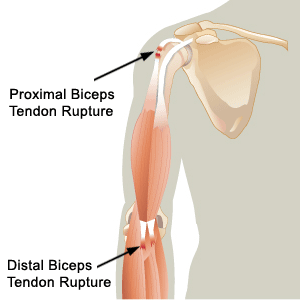Towards the end of last year, I wrote a blog about an
Achilles tendon rupture. A similar type of injury can occur in the upper arm to
the biceps tendon, where this tendon is torn off the humerus bone in the upper
arm. The biceps tendons attach the biceps muscles to the bone at the shoulder
joint (long and short head of biceps tendon) and at the elbow joint.
Causes
Biceps tendon rupture is either caused by chronic
degeneration of the tendon, or by an acute traumatic injury. Prolonged
tendinitis of the biceps tendon, as a result of excessive prolonged overhead
movements, such as swimming, make the tendon weak and more susceptible to
tearing. In biceps tendon ruptures at the shoulder, the rupture tends to occur
as a result of the tendon continually passing over the head of the humerus, causing
degeneration of the tendon. This is more commonly seen in older individuals who
have participated in activities involving repeated overhead movements of the
arm over a long period of time. Alternatively, the biceps tendon can rupture
during a traumatic event, such as heavy weightlifting.
Signs and Symptoms
An individual may hear and/or feel a snapping sensation at
the site of the tear and there is usually intense pain. The following may also
be present:
·
Skin discolouration and bruising in the upper
arm
·
A visible abnormality in the muscle belly when
the elbow is bent
·
In the case of a rupture of the long head of the
biceps tendon at the shoulder, there is an obvious “Popeye” appearance, where
the muscle belly bulges out (like Popeye when he flexes his biceps)
·
Ruptures at the elbow result in pain and
weakness near the elbow, especially when bending the elbow and turning the palm
upwards
Treatment and Management
In a complete biceps tendon rupture, surgery is required to
reattach the tendon to the bone, especially in younger, more active
individuals. A sling is then used to ensure the arm remains immobilized while
the tendon heals. Physiotherapy is required to regain range of motion in the
shoulder joint. Finally, biokinetic therapy is essential to final phase rehabilitation,
to provide stretching and strengthening exercises in order to regain full
function. In the less active population, surgery is not necessary, as adequate
function can be regained with the help of an appropriate exercise rehabilitation
programme.
References
Foundations of Athletic Training: Prevention, Assessment and
Management

ReplyDeleteMy husband was diagnosed with early onset Parkinson's disease at 57.his symptoms were shuffling of feet,slurred speech, low volume speech, degradation of hand writing, horrible driving skills, right arm held at 45 degree angle, things were tough for me, but now he finally free from the disease with the help of total cure ultimate health home, he now walks properly and all symptoms has reversed, he had trouble with balance especially at night, getting into the shower and exiting it is difficult,getting into bed is also another thing he finds impossible.we had to find a better solution for his condition which has really helped him a lot,the biggest helped we had was ultimatehealthhome they walked us through the proper steps,am highly recommended this ultimatehealthhome@gmail.com to anyone who needs help.
After years of battling COPD with little to no lasting relief, I turned to the herbal treatment from NaturePath Herbal Clinic—and it’s one of the best decisions I’ve made.
ReplyDeleteWithin just four months, I experienced noticeable improvements: easier breathing, reduced coughing, and a significant decrease in chest tightness. I'm now able to walk longer distances, sleep more soundly, and enjoy daily activities without constant fatigue or shortness of breath.
This treatment has genuinely transformed my quality of life. If you're seeking a natural and effective solution for COPD, I wholeheartedly recommend NaturePath Herbal Clinic.
Learn more: www.naturepathherbalclinic.com